volcanic rock sample from the reservoir of CO2 in a fracture mineralization seen carbonates. / Annette K. Mortensen
The forests through wood, and oceans through the plankton, corals and fish are the main natural carbon sinks. Thanks to them, the CO2 atmosphere is absorbed and stored. But high levels of this gas acidify the oceans, which are saturated. Scientists look for artificial solutions to remove from the atmosphere this greenhouse gas, responsible for the current climate change.
In Iceland, where the center of the world’s largest geothermal, an international team of researchers has designed a system through which atmospheric carbon dioxide is injected into volcanic rock. Scientists demonstrate for the first time the CO2 is digested almost completely in a matter of months, much faster than thought.
The study, published in Science, suggests so volcanic basalt rocks -some of the most abundant in the Earth’s crust can effectively store the extracted gas from the atmosphere. So far he had tried unsuccessfully to inject CO2 in underground rocks denuded of silicates rich in calcium, magnesium and iron needed to transform the greenhouse gas carbonates, which are more stable. But this technique involved if CO2 leaks in the rock fractures occurred.
For years, scientists seek technologies for capture and storage of this gas safely. In fact, the report of the Intergovernmental Panel on Climate Change published in 2014 warned that without these techniques will be impossible to limit global warming.

Aerial Photography Hellisheidi Reykjavik Energy geothermal plant that emits 40,000 tons of CO2 per year. / Árni Sæberg
In the case of this geothermal power plant called Hellisheidi, which pumped water heated from volcanic rocks to run the turbines, the production process energy emitted 40,000 tons of CO2 per year. Therefore, from 2012, the plant started the project CarbFix 250 tons of gas mixing with water pumped from below and hydrogen sulfide. The result was injected into the volcanic basalt that was at a depth of between 400 and 800 meters.
Being the rock exposed to CO2 and water, there was a series of chemical reactions and eventually carbon it became whitish calcareous mineral. This process could have taken hundreds or thousands of years in most rocks, according to previous studies. However, in the volcanic below the central rocks, 95% of the injected coal is solidified in less than two years.
“This means we can pump large amounts of CO2 and store it in a very safe in a very short time, “says Martin Stute, study co-author and a hydrologist at the Lamont-Doherty Earth Observatory of Columbia University (USA). “In the future they could use these geothermal plants in places with lots of basalt and there are many locations,” he adds. In fact, the entire ocean floor is covered by this black and porous rock.
After the success of the first experiment, the consortium of scientists has begun to inject CO2 at a rate of 5,000 tons per year since 2014, and mineralization has kept pace. This summer, the company plans to injection double.

Removing rock samples after injection of CO2 conducted in the CarbFix project. / Juerg Matter
Original article here.
No comments:
Post a Comment